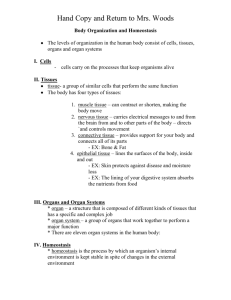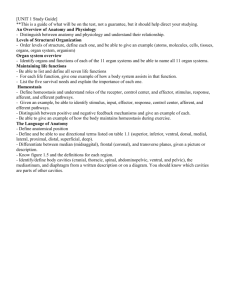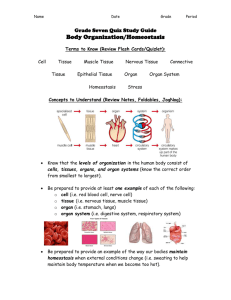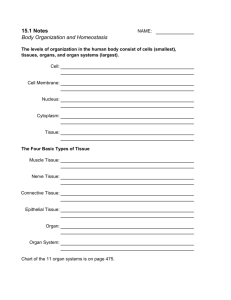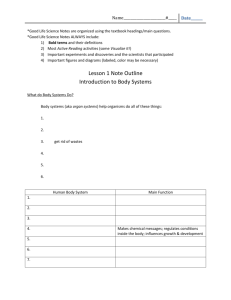Human Physiology and Anatomy
advertisement
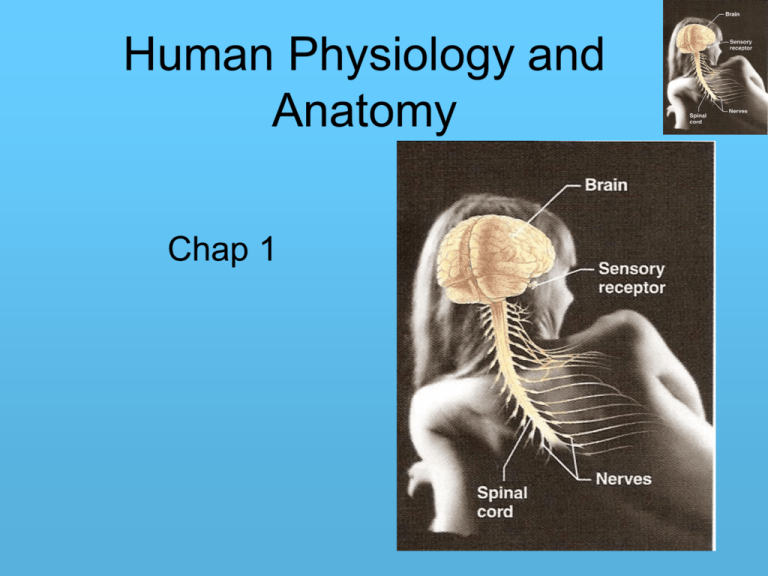
Human Physiology and Anatomy Chap 1 Anatomy and Physiology • Anatomy = Structure (form) • Physiology = Function "All specific functions are performed by specific structures!" Course expectations Skills other than content: • Note taking • Using other resources • Study disc • Quest in book • Websites • Color pgs- use of colors to help remember • Vocab/ flashcards- word dissections • Text Lab book • Diagramming • Study partners • Researching new info Textbook Web Resource • Website: http://www.phschool.com/access/marieb_human _anat.html Student registration Access code: SSNAST-ABOHM-MAPLE-MEWED-TAINT-WIPES Or email me an I’ll forward the link and access code so you can cut and paste Text website • http://wps.aw.com/wps/media/access/Pear son_Default/560/573796/login.html Grading Grading: The following breakdown is approximate: • Exams: 50% • Quizzes: 10% • Labs: 10% • Lab Practicals: 20% • Homework: 5% • Case Studies: 5% Standard Grading Scale • 100% - 90% = A • 89% -80% = B • 79% - 70% = C • 69% -60% = D • 59%-0%=F • ASSIGNMENTS AND DUE DATES • All homework and lab reports are due on the assigned date. Except for an excused absence, LATE WORK WILL NOT BE ACCEPTED. Guests Speakers • Invite a guest speaker to class. • 3rd week of school until Christmas break. • Only one speaker each week -not enough weeks for all students to schedule a speaker. • “Speaker Credit” may replace one test score with 100%. All tests must be taken-redeem your credit at the end of the semester. • To earn the credit, you must show a thank you letter and a stamped/addressed envelope. Learning • • • • • Read it Hear it See it Do it Teach it Note taking • Practice in class pgs 2-13 (Mostly review from Biology) • Groups assigned sections- take notes on your sections using your own style (15 min) • Sections present so whole class has all notes Summarize Note-taking 1. What format(s) have worked well for you for note-taking? (outlining, 2 column, complete sentences, paraphrasing, diagraming and labeling, recording and listening to many times………..) 2. What new tecnique(s) did you see today that might help improve your note-taking Microscopic Anatomy • Cytology – study of the cell • Histology – study of tissues Physiology • Understanding physiology also requires a knowledge of physics, which explains electrical currents, blood pressure, and the way muscle uses bone for movement Principle of Complementarity • Function always reflects structure • What a structure can do depends on its specific form Levels of Structural Organization • Chemical – atoms combined to form molecules • Cellular – cells are made of molecules • Tissue – consists of similar types of cells • Organ – made up of different types of tissues • Organ system – consists of different organs that work closely together • Organism – made up of the organ systems Levels of Structural Organization Smooth muscle cell Molecules 2 Cellular level Cells are made up of molecules Atoms Smooth muscle tissue 3 Tissue level Tissues consist of similar types of cells 1 Chemical level Atoms combine to form molecules Heart Cardiovascular system Epithelial tissue Smooth muscle tissue Connective tissue 4 Organ level Organs are made up of different types of tissues Blood vessels Blood vessel (organ) 6 Organism level The human organism is made up of many organ systems 5 Organ system level Organ systems consist of different organs that work together closely Figure 1.1 Organ Systems of the Body • Integumentary system – Composed of the skin, sweat glands, oil glands, hair, and nails • Skeletal system • Muscular system • Nervous system • Cardiovascular system • Lymphatic system • Respiratory system • Digestive system • Urinary system • Reproductive system – Male – Female Necessary Life Functions • Metabolism – all the chemical reactions that occur in the body • Excretion – removal of wastes from the body • Reproduction – cellular and organismal levels – Cellular – an original cell divides and produces two identical daughter cells – Organismal– sperm and egg unite to make a whole new person • Growth – increase in size of a body part or of the organism Survival Needs • Nutrients – chemical substances used for energy and cell building • Oxygen – needed for metabolic reactions • Water – provides the necessary environment for chemical reactions • Maintaining normal body temperature – necessary for chemical reactions to occur at lifesustaining rates • Atmospheric pressure – required for proper breathing and gas exchange in the lungs Homeostasis • Homeostasis is the ability to maintain a relatively stable internal environment in an ever-changing outside world • The internal environment of the body is in a dynamic state of equilibrium • Chemical, thermal, and neural factors interact to maintain homeostasis Homeostatic Control Mechanisms • The variable produces a change in the body • The three interdependent components of control mechanisms are: – Receptor – monitors the environments and responds to changes (stimuli) – Control center – determines the set point at which the variable is maintained – Effector – provides the means to respond to the stimulus Homeostatic Control Mechanisms 3 Input: Information sent along afferent pathway to Control center 4 Output: Information sent along efferent pathway to Effector Receptor (sensor) 2 Change detected by receptor 1 Stimulus: Produces change in variable Variable (in homeostasis) 5 Response of effector feeds back to influence magnitude of stimulus and returns variable to homeostasis Figure 1.4 Negative Feedback • In negative feedback systems, the output shuts off the original stimulus • Example: Regulation of blood glucose levels Negative Feedback Figure 1.5 Positive Feedback • In positive feedback systems, the output enhances or exaggerates the original stimulus • Example: Regulation of blood clotting Figure 1.6 Homeostatic Imbalance • Disturbance of homeostasis or the body’s normal equilibrium • Overwhelming of negative feedback mechanisms allowing destructive positive feedback mechanisms to take over Anatomical position •Supine- Face up •Prone- Face down Body Planes Body Planes Links • Website of body planes animated • Visable Human- Male sections • Visable Human- Female sections Directional terms anterior (ventral) posterior (dorsal) superior (cranial) inferior (caudal) medial lateral intermediate proximal distal superficial deep parietal visceral = = = = = = = = = = = = = front back upper lower midline away from midline between medial and lateral point of origin away from origin external/surface internal/beneath surface associated with body wall associated with organ Regional terms- anterior view Regional terms- posterior view Cavities • dorsal cavity--lined with fibrous periosteum (here, a portion of the dura mater), contains central nervous system a. cranial cavity--within skull, contains brain b. spinal cavity--within vertebral canal, contains spinal cord • ventral cavity--lined with serous membrane, contains respiratory, cardiac, digestive, urinary, and reproductive viscera a. thoracic cavity--within rib cage, floor is diaphragm (1) right and left pleural cavities--contain lungs (2) pericardial cavity--contains heart and is part of the mediastinum b. abdominopelvic cavity--occupies much of lower front torso (1) abdominal cavity--contains stomach, liver, spleen, kidneys, most of the small and large intestine (2) pelvic cavity--contains the urinary bladder and most of the parts of the reproductive system Body cavities Other Cavities Body Regions right hypochondriac epigastric left hypochondriac right lumbar umbilical left lumbar right illiac hypogastric left illiac • Useful prefixes: Hypo- below Epi – above Gastri – belly Chondro - cartilage Abdominals Regions with organs Abdominal Quadrants with organs Abdominals Regions w/o organs Membranes • Serous (serosa) = Parietal (covers cavity) and Visceral (covers organ) • Fibrous = non-fluid filled, structural

